Poultry farming is the commercial raising of domesticated birds to increase egg and meat production. Birds raised on farms are usually chickens, turkeys, ducks, and geese for food. However, there is a global chicken market where broilers are raised for meat and layers for eggs. The term “poultry farming” can be used primarily for chicken farming, as chickens are often raised and bred. Here are some tips you should consider when starting your poultry farm successfully.
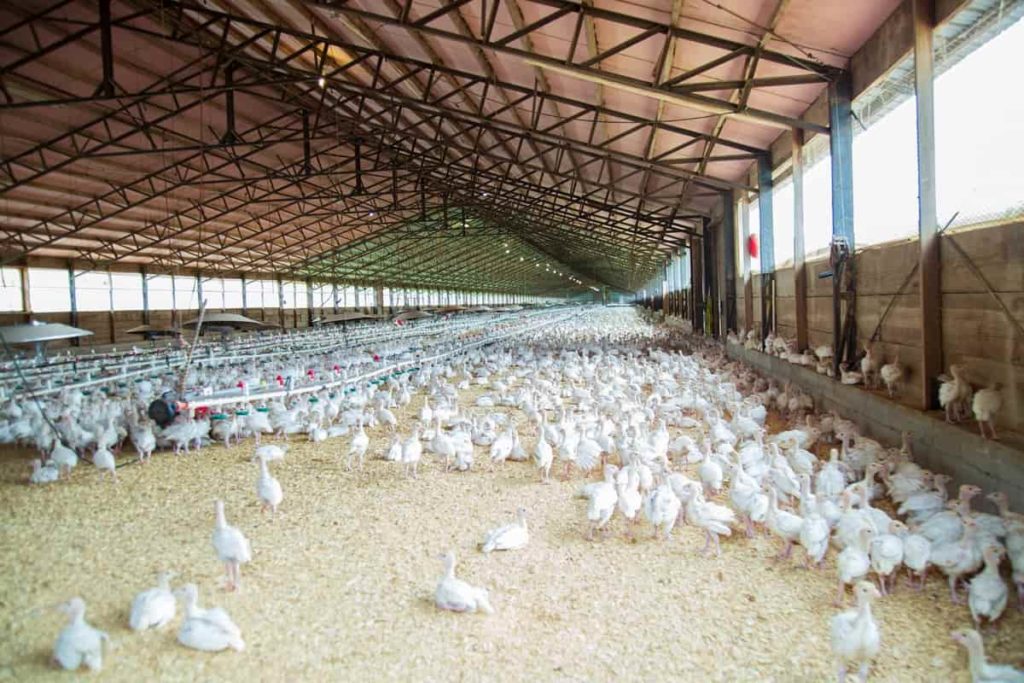
How to start poultry farming from scratch
What investment is required to start a poultry farm?
Poultry farming is a capital-intensive business; depending on the scale and business you want to start with, the fund requirement can be Rs. 1.5 lakh to Rs.10 lakh. The funds required for poultry farm are for various purposes, including:
- Cost of poultry birds
- Cost of place on rent
- Cost of equipment
- Cost of staff
- Cost of poultry feed and other raw materials
- Marketing, transportation, and miscellaneous cost
If you are considering starting a small-scale poultry farm, you will need around INR 50,000 to INR 1,50,000. To start a medium-sized poultry business, you may need around Rs 1.5 lakh to Rs 3.5 lakh. And for a large-scale poultry farm, you will need to invest around Rs 7 lakh to Rs 10 lakh.
What are poultry and its importance?
- In poultry farming, birds are raised domestically or commercially for meat, eggs, and feathers.
- Chickens, ducks, turkeys, and geese poultry birds are of primary commercial importance, while guinea fowl and squabs are of mainly local interest.
- Poultry meat is an important source of high-quality protein, minerals, and vitamins to balance the human diet. Specially developed chicken breeds (broilers) are now available with rapid growth and high feed conversion efficiency.
- There are many benefits to keeping chickens. Poultry birds provide companionship to humans, a source of food in the form of eggs and meat. Apart from this, farmers like to display their chickens in poultry shows. In addition, some people like to keep chickens in their backyard as pets or for fresh eggs daily.
What is the process of poultry farming?
- Creating a business plan
- Selection of location and procurement of required equipment
- Deciding on the replacement of birds used in poultry farming
- Taking steps to maintain and manage the poultry farm.
What are the problems of poultry farming?
- Foodborne and zoonotic diseases are strongly linked to poultry.
- The eradication, eradication, and control of foodborne and zoonotic pathogens is a major challenge for the poultry industry.
- In addition, public health risks from food and drink with high antibiotic residues will remain a significant issue.
Which one is profitable broilers or layers?
In the long run, large-scale layer farming will be more profitable and generate more income than broiler farming because after laying eggs, the birds can be sold as meat, albeit at a lower price than broilers.
How many types of poultry farms are there?
Battery Cage Poultry Farm – For a battery cage poultry farm, you may need 4,000 square feet for the birds and an additional 2,000 square feet for other infrastructure needs of the farm. In a battery cage system, the birds will not be able to move or run.
Free Range Poultry Farm – You will need around 12,000 to 36,000 square feet of space in a free-range poultry farm. As in the poultry system, the birds are released free-range in the fields.
Semi-Range Poultry Farms – These poultry farms are a combination of both free-range and cage systems. In this system, the poultry birds are housed in a coop and provided with a small pen/paddock to roam around. You will need around 8000 square feet for this type of poultry farm. Two square feet of coop space and 2 square feet of paddock space mean a total of 4 square feet per bird.
Completely Wild Poultry Farm – Finally, in wild poultry systems, the birds are raised in a natural environment, such as an area with many trees. In this system, you will need about 44,000 square feet of space by having 2 square feet of coop space for the birds and about 15-20 square feet of free-range space.
In case you missed it: 12 Key Rules for Effective Poultry Farm Management: From Planning to Reducing Production Cost
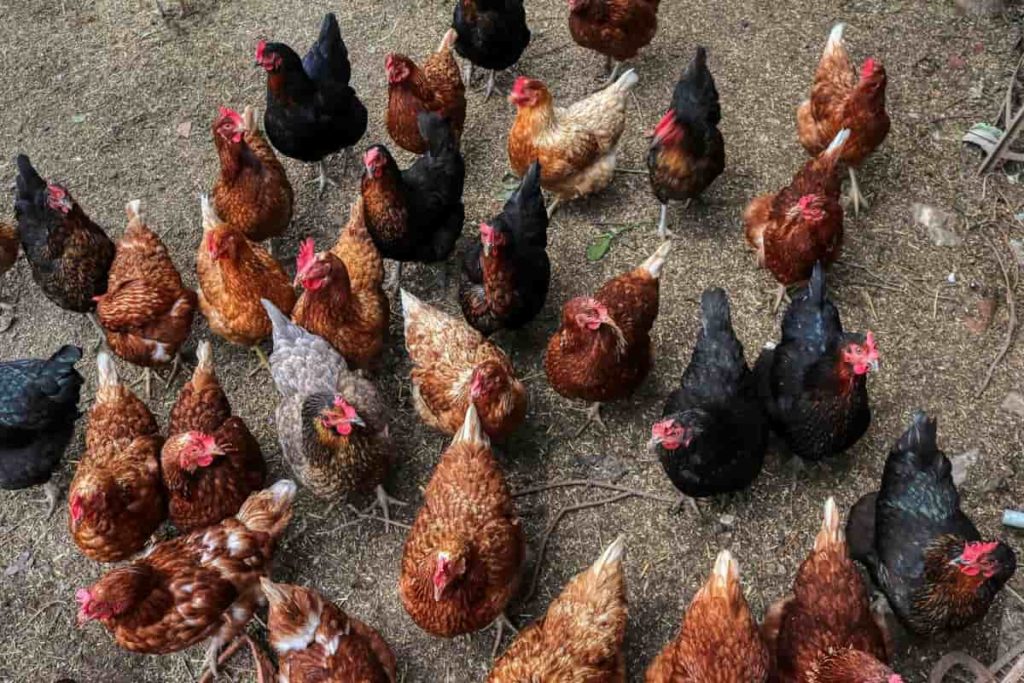
How much land is required to start poultry farming?
Broiler Poultry: By 18 days, broilers require 450 cm2 of floor space, 3 cm of feed space, and 1.5 cm of water. Birds 19 to 42 days of age require 1000 cm2, 6-7 cm feed space, and 3 cm water space.
Layer Poultry: In the case of a deep litter system, floor space of about 2 square feet per bird should be provided. In a cage system, floor dimensions should be 18 inches x 12 inches. This space is enough to accommodate 3 to a maximum of 5 birds.
Country Chicken: Baby chickens raised in deep litter require about 280 cm² of floor space per baby chicken. Approximately one square foot of floor space should be provided from the sixth week onwards. Overcrowding birds in the brooding stage can cause stress resulting in infection and mortality. Feed conversion ratio and growth should be proportional to the floor space available for the baby chickens.
What are the advantages of poultry farming over livestock farming?
- Production in poultry farming is quite high.
- It requires less investment as compared to cattle farming.
- It helps in providing nutritious food to the common people.
- As mentioned, poultry farming is a fast-growing business due to the increasing demand for poultry products.
- Poultry farming is a high-productivity business. It does not require much capital. It doesn’t need much space.
- Getting a license is easy.
- Apart from creating employment, highly skilled labor is not required.
- Low maintenance is required.
Is poultry farming a profitable business?
- It is one of the most profitable agribusinesses in the current Indian market. Moreover, the poultry business is a great idea for those who want to pursue a successful agribusiness career.
- Do not start a large-scale poultry farming business if you are inexperienced in the market.
- It would help if you did a proper study before going into business. Then, if there are many competitors or the supply of poultry products exceeds the demand in your area, look elsewhere to start your business or find another business to start.
- Environmental conditions are often automatically controlled by producers. For example, the presence of light helps the bird lay eggs earlier. Therefore, producers should provide a more extended light period to increase the chances of egg laying. An egg-laying bird lays more eggs in the warm and cold months.
How much loan can I get for poultry farming?
- For every 5000 bird farms, the loan amount will be up to Rs.3 lakh. Therefore, the maximum loan amount is Rs.9 lakh/farmer.
- For security, the individual must take a mortgage of the land on which the poultry shed and other infrastructure are available or planned to be constructed, covering at least 50% of the advance.
How much profit is there in a poultry farm?
- If you start layer farming on a small scale, i.e., 1500 chickens, you can earn from 50000 to 1 lakh per month.
- For this, you first need to find a place for poultry farming. About 1-2 lakhs will be spent on cages and equipment. 50000 should be budgeted for the purchase of chickens.
What are the 4 types of poultry housing?
Deep litter system
In this system, the birds are kept indoors at all times. Feed, water, and nesting are arranged indoors. Birds are placed on suitable litter material about 3 to 5 inches deep. Generally, paddy husk, sawdust, ground nut hull, chopped paddy straw, or wood shavings are used as litter material. This arrangement saves the labor involved in frequently cleaning the fecal matter, but it requires occasional agitation. Litter is spread over the floor in layers of 2 inches high every fortnight until the desired is achieved.
Slatted floor system
In slatted floors, iron bars or wooden wrappers are used as the floor, usually 2-3 feet above ground level, to facilitate the slats from falling through. Wood rappers or iron bars 2 inches in diameter can be used along the length of the house with a 1-inch space between the rods. Advantages are;
- Less flooring is required per bird than solid flooring systems
- Bedding is eliminated
- Handling of manure is avoided
- Increased sanitation
- Labor savings
- Soil-borne infections are controlled
In case you missed it: Poultry Farming in Nepal: How to Start, A Step-By-Step Guide for Beginners
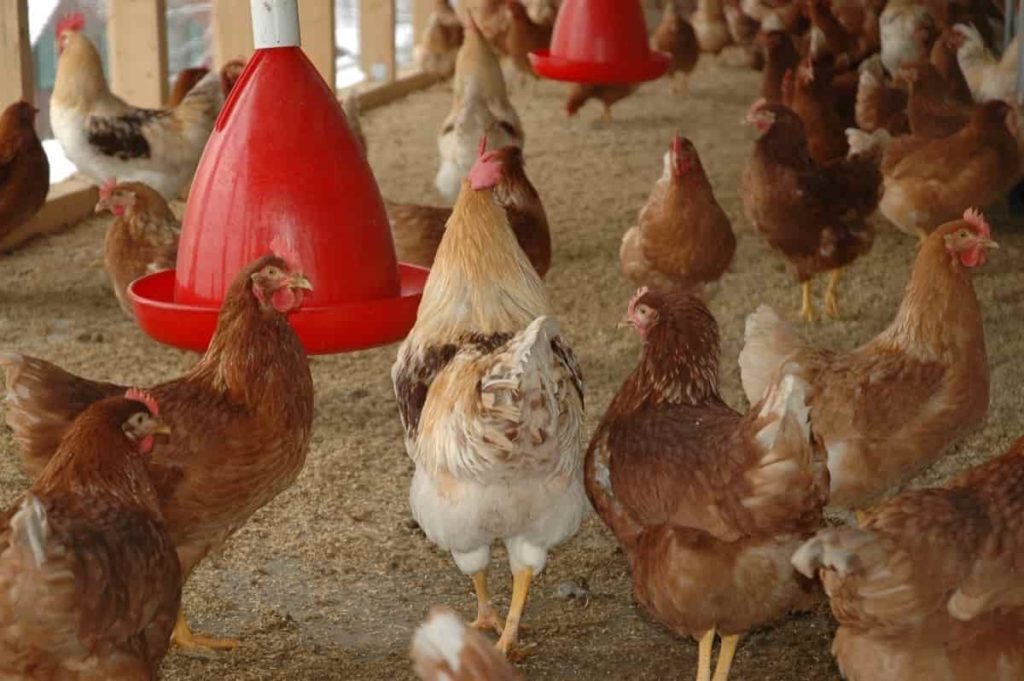
Slat-cum-litter system
This system is commonly used to raise birds for egg production, especially meat-type breeders. Here, part of the floor area is covered with slats. In the case of a breeder flock, nest boxes are usually placed in the litter area. Advantages are;
- More eggs can be produced compared to all solid floors.
- Fertility is better with a slat-less litter house than with an all-slat house.
Cage system
This system involves raising chickens in small compartments on a wire mesh floor, called cages, either standing on the house floor or hanging from the roof. It has proven to be very useful for laying operations, from day-old to disposal. Currently, 75% of commercial layers worldwide are kept in cages.
Feeders and waterers are connected to the cages externally except for nipple waterers, for which the pipeline is routed through or over the cages. Self-propelled feeding trolleys and egg collection belts can also be used in this rearing system. The droppings are collected either in trays under the cages, belts, floor, or deep pits under the cages, depending on the type.
What is the importance of using proper tools and equipment on a poultry farm?
Quality poultry equipment is essential to raising healthy chickens and other poultry birds. Investing in poultry farm equipment is essential to running a successful business delivering high-quality products. Poultry farming involves a variety of machinery, including climate control, drinking, feeding, incubator equipment, egg collection and handling, broiler harvesting, slaughtering, and hatchery equipment.
- Incubator: Incubator is poultry equipment used to incubate bird eggs artificially. There are several types of egg incubators on the market.
- Egg tray: It is the equipment used in arranging eggs. Like the name, it is a tray-like device where eggs are sampled.
- Ventilation fan: A ventilation fan is equipment that ensures maximum ventilation in poultry farms. It is also equipment used to reduce the temperature of the poultry farm in hot weather.
- Nesting: Nesting is another piece of equipment that helps birds to lay eggs. One of the advantages is that it increases the egg productivity of poultry birds.
- Feeder: A feeder is an equipment used to feed poultry birds. Usually, some food is placed in the feeder, and the chickens start eating from there. Plastic or metal feeders are mainly used for feeding chickens.
- Heater: Heat management is essential for poultry farming. Bulbs, heaters, or other heating devices can heat the chicken coop.
- Egg handling nest: Egg handling nests or cages transport eggs from one place to another. It reduces the risk of egg damage during transportation for marketing purposes.
- Brooder machines: Brooder machines provide heat and lighting to the baby chickens.
What are the types of poultry farming?
Two types of chickens are generally reared in poultry farming. They are layers and broilers. Layers are raised only for eggs, while broilers are raised for meat. Generally, layers and broilers require the same equipment and facilities.
Which poultry is the most profitable?
- Poultry farms are relatively easy to construct and maintain. Unlike cattle and sheep, poultry birds require less space to grow. They are also easy to care for.
- On a poultry farm, your feed demand is low. Birds will eat almost anything, from leftovers to vegetables.
- Chickens are by far the most profitable birds to raise. Because chicken prefers meat, raising chickens will set your business right. Turkey is a poultry bird that guarantees a stream of income.
In case you missed it: Poultry Farm Insurance in India, Companies, Policy, and Premium
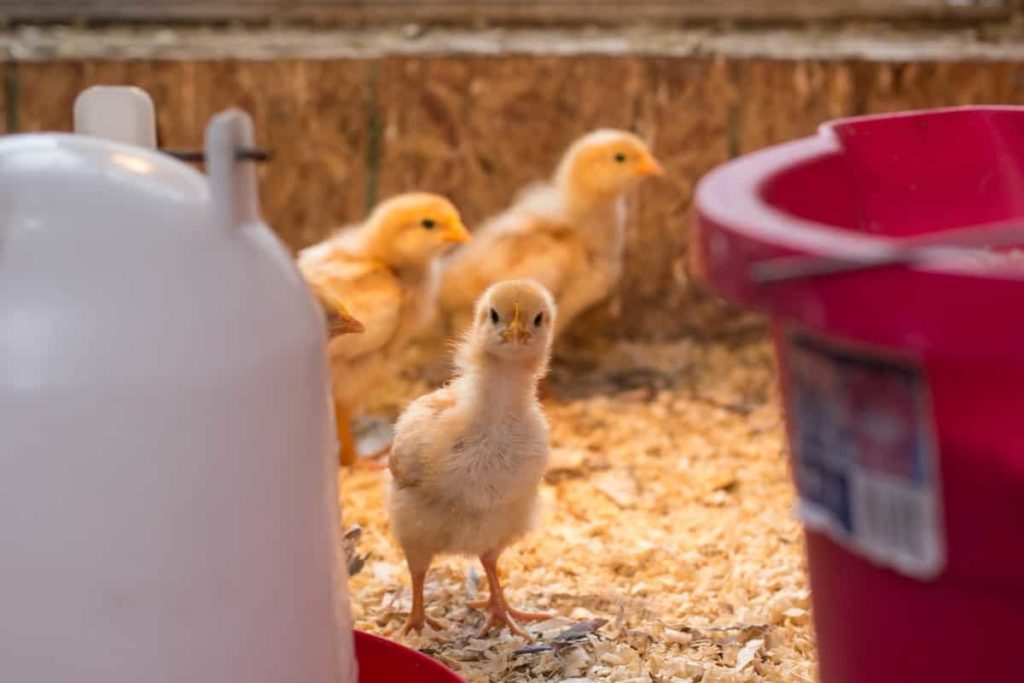
How many chickens can 1-acre support?
- It is recommended to keep about 50 chickens per acre, with a maximum of about 100 for free-range, ethically kept birds.
- Under very specific conditions, you can have 400-500 chickens per acre as long as you rotate them.
How can we improve poultry farming?
- Another tip for poultry farming is to have your feed mill produce chicken feed.
- Production of chicken feed is not that difficult. If you can reduce feed production costs, you can increase your business’s overall profit.
- Improving poultry nutrition is a solution to address potential nutritional deficiencies of the feed or increase its nutritional value.
- Another important factor that can help you get maximum profit from poultry farming is feed optimization.
- Feed optimization is crucial because feed accounts for a large portion of the cost of chicken production. In addition, birds need food and water, which they convert into their bodies to produce meat and eggs. Therefore, to maximize your poultry profits, you must reduce the cost of feeding the birds.
What is the most effective way of preventing poultry diseases?
- Vaccination is one of the most effective ways to prevent certain diseases.
- Vaccinate poultry birds carefully. So that they are protected from the outbreak of explosive diseases.
How do I keep my chicken’s disease free?
- Keep it clean – Clean, sanitize, and disinfect your poultry house regularly.
- Change the litter
- Be careful adding birds
- Monitor visitors
- Use standard feed
- Learn about vaccines
- Have a comfortable coop
What are the main things to consider before starting a business?
Poultry farming is a vast industry from which many sub-sectors are selected. Here is a list of sectors one can choose from:
1. Choose the sector that suits your interest; these include-
- Meat production (through broiler breeding)
- Egg production (through layers breeding)
- Production of poultry feed
- Requires the manufacture of equipment in poultry farming
- Egg and meat processing
- Chicken hatching
- Egg and meat packing and marketing
Depending on one’s interest and feasibility, an entrepreneur can choose to start a business in more than one segment.
2. Select the poultry birds you want to raise on your farm. It is advisable to select from a limited variety of broilers and layers for meat and egg production. As the poultry business grows, more bird species can be added depending on demand and profitability.
3. Select the poultry farm location. Rather than creating a logistical nightmare and increasing transportation costs, locating the goods further away from the point of consumption is advisable. Finalize the space in advance from where operations can be easily managed.
4. It is important to name your farm and register it as per state laws. Creating a logo for your business is also important if you plan to market your products online and supply them to remote locations.
5. Arrange the finances – The poultry business is not capital-intensive and requires limited initial capital. Poultry funds are required for various purposes, including buying/renting land and equipment, hiring employees and poultry, managing cash flow, paying salaries, etc.
How many times a day do you feed the chickens?
Ideally, you should divide your chicken feed into two servings per day. However, you can make these 3-4 small feedings if you are home during the day. Chickens enjoy small, frequent meals instead of large meals once daily.
How do I start a poultry business?
- Learn poultry farming
- Choose your poultry sector
- Choose the correct type of bird
- Create your farm logo
- Determine the placement of the farm
- Have a business plan
- Take a loan
- Install an excellent poultry housing system
What are the important methods of feeding poultry?
- Feeding your chickens doesn’t have to be complicated. Chickens aren’t usually picky eaters, and you may have more trouble stopping them from eating things they shouldn’t than eating things they might.
- A healthy diet will stimulate healthy egg production and improve immunity.
- To feed for laying hens, mix whole cornmeal, soya, fish meal, corn bran, and limestone powder in a large bucket or barrel. Then, stir them with a shovel until they are well mixed so that the chickens get the nutrients from all the ingredients at once.
What are the requirements for a poultry farm?
- Choose your poultry sector – In broad terms, there are two types of poultry farming – broilers and layers.
- Select the type of bird – You can start a small poultry farm by initially choosing two to three birds and later adding more birds, depending on the growth of the business.
In case you missed it: Common Mistakes Everyone Makes in Poultry Farming
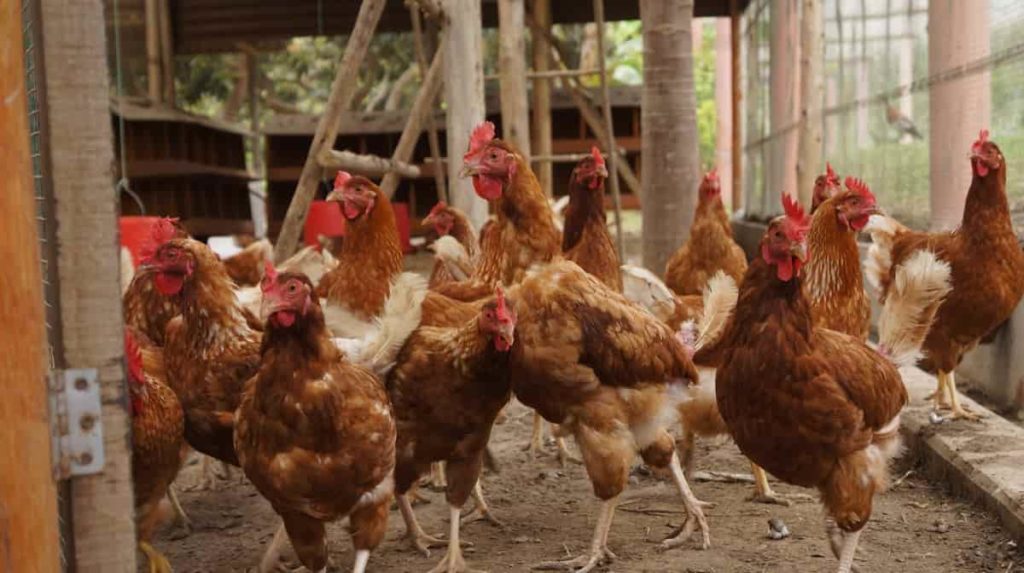
How can I make my chickens healthy?
Keeping chickens healthy provides them with clean living space, nutritious food, clean water, and isolation from pathogens.
- Maintain a healthy flock
- Give them space
- Keep them dry
- Feed them well
- Protect them
- Keeping diseases away
What is the proper orientation of the poultry house?
- The poultry house should be east-west oriented, with ventilation windows facing south and north. No windows on either east or west side should prevent sun rays from entering.
- A small poultry farm does not require any special arrangement as it only involves the construction of a house. However, medium—and large-size farms require special considerations for building space within the farm premises.
Basic rules to be observed for layout are;
- The layout should not allow visitors or outside vehicles to approach the birds.
- The sheds should be located so fresh air passes through the brooder shed first, followed by the grower and layer sheds. This layer prevents the spread of diseases from the houses to the brooder house.
- There must be a minimum distance of 50-100 feet between the baby chicken and grower shed, and at least 100 meters between the grower and layer shed.
- The egg store, office, and feed store rooms should be near the entrance. Disposal pits and sick rooms should be constructed only at the end of the site.
What is the best poultry housing system?
Need for poultry house
- To protect birds from adverse climatic conditions
- To ensure easy and economical operation
- Facilitating suitable micro-climatic conditions in the vicinity of birds
- Suitable for effective disease control measures
- To ensure proper supervision
To ensure supervision, an open-sided poultry house should be approximately 30 feet wide and no more than 40 feet wide. Wide houses will not provide enough ventilation in hot weather. Wide houses also require additional internal supports that may interfere with equipment or manure removal.
Characteristics of a good poultry housing system;
- Controlled access
- A comfortable floor or bedding for birds
- Easy to clean
- Easy egg collection
- Good lighting and heating system
- Adequate ventilation
- The efficient waste disposal unit
- Distribution for different ages and species of birds
In case you missed it: Equipment Needed for Poultry Farming: Tools, and PDF
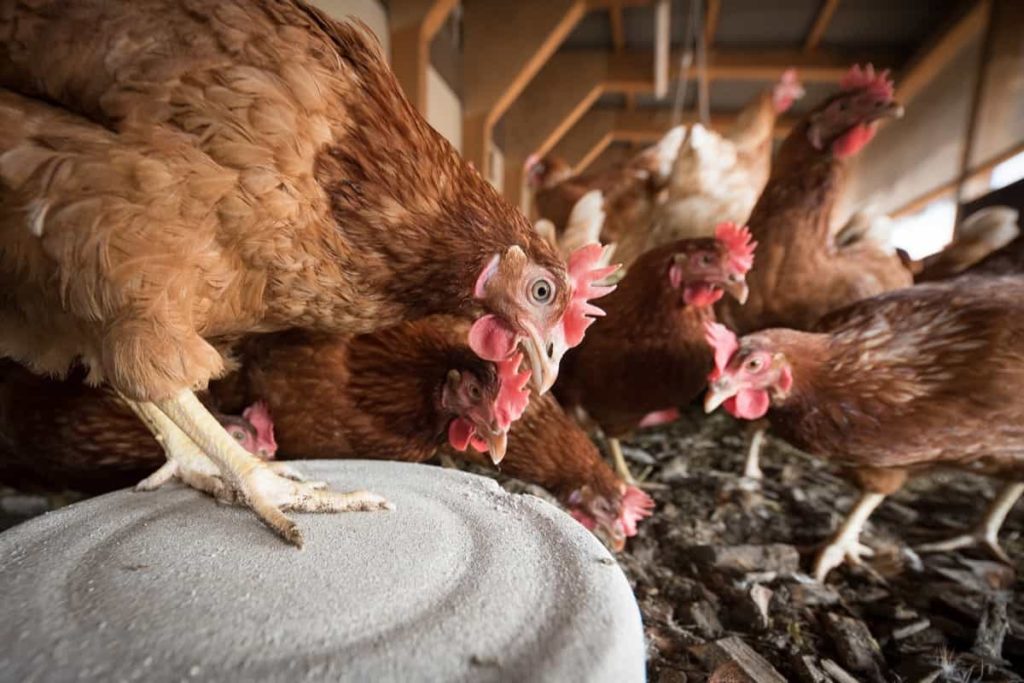
How do I market my poultry products?
- To start a poultry farming project, a marketing plan must analyze your market supply and demand and understand your target customer.
- Marketing is a system of bringing products to the market and highlighting their relative benefits that differentiate them from other products after taking all the standard steps to persuade the consumer to buy a particular product and avoid buying other products.
- Poultry and its products are not stored for a long time, so the speed of marketing is very important, marketing of the product requires sacrifice to the extent that huge losses to market the product, and the company must care in dealing with customers at the time of sale as they deal in time of depression.
Conclusion
Poultry farming information will help your poultry birds live, grow, and thrive happily. Processing, preservation, and marketing channels should be established for a profitable poultry farming business. Above are some crucial tips for every poultry businessman and marketer to get the maximum of the poultry business.
- How to Make Houseplants Bushy: Effective Tips and Ideas
- Innovative Strategies for Boosting Coconut Pollination and Yield
- Pollination Strategies for Maximum Pumpkin Yield
- The Complete Guide to Chicken Fattening: Strategies for Maximum Growth
- Natural Solutions for Tulip Problems: 100% Effective Remedies for Leaf and Bulb-Related Issues
- Revolutionizing Citrus Preservation: Towards a Healthier, Greener Future
- Natural Solutions for Peony Leaf and Flower Problems: 100% Effective Remedies
- Maximizing Profits with Avocado Contract Farming in India: A Comprehensive Guide
- Natural Solutions for Hydrangea Problems: 100% Effective Remedies for Leaf and Flowers
- The Ultimate Guide to Choosing the Perfect Foliage Friend: Bringing Life Indoors
- From Sunlight to Sustainability: 15 Ways to Use Solar Technology in Agriculture
- The Ultimate Guide to Dong Tao Chicken: Exploring from History to Raising
- The Eco-Friendly Makeover: How to Convert Your Unused Swimming Pool into a Fish Pond
- Mastering the Art of Delaware Chicken Farming: Essentials for Healthy Backyard Flocks
- 20 Best Homemade Fertilizers for Money Plant: DIY Recipes and Application Methods
- How to Craft a Comprehensive Free-Range Chicken Farming Business Plan
- Brighten Your Flock: Raising Easter Egger Chickens for Beauty and Bounty
- How to Optimize Your Poultry Egg Farm Business Plan with These Strategies
- Subsidy for Spirulina Cultivation: How Indian Government Schemes Encouraging Spirulina Farmers
- Ultimate Guide to Raising Dominique Chickens: Breeding, Feeding, Egg-Production, and Care
- Mastering the Art of Raising Jersey Giant Chickens: Care, Feeding, and More
- Ultimate Guide to Raising Legbar Chickens: Breeding, Farming Practices, Diet, Egg-Production
- How to Raise Welsummer Chickens: A Comprehensive Guide for Beginners
- How to Protect Indoor Plants in Winter: A Comprehensive Guide
- Ultimate Guide to Grow Bag Gardening: Tips, Tricks, and Planting Ideas for Urban Gardeners
- Guide to Lotus Cultivation: How to Propagate, Plant, Grow, Care, Cost, and Profit
- Agriculture Drone Subsidy Scheme: Government Kisan Subsidy, License, and How to Apply Online
- Ultimate Guide to Raising Araucana Chickens: Breed Profile, Farming Economics, Diet, and Care
- Bringing Hydroponics to Classroom: Importance, Benefits of Learning for School Students
- Ultimate Guide to Raising Polish Chickens: Breed Profile, Farming Economics, Diet, and Care
- Ultimate Guide to Raising Australorp Chickens: Profile, Farming Economics, Egg Production, Diet, and Care
- Silkie Chicken Farming: Raising Practices, Varieties, Egg Production, Diet, and Care
- Sussex Chicken Farming: Raising Practices, Varieties, Egg Production, Diet and Care
- Homemade Feed Formulations for Livestock: Discover Cost-effective Starter to Finisher Feed Recipes
- 20 Best Pig Weight Gain Supplements: Top Swine Weight Gain Formulas
- Ultimate Guide to Elderberry Farming: Propagation, Planting, Yield, Cost, and Profit
Good day
I would like to know about poultry farming and I’m very interested on starting my small project for poultry farming.
Thank you so much for the information,I really want to start a small poultry,but I’m afraid of loosing
With the above information,I can start with maybe 30 Burt’s to see how far I can maintain them
I I still need additional information
I want to know about how to start poultry farming
All information providing here it is very much important. I need help from you.I need to start the poultry farming business, I do have a lack of funds.I got certificate of farming. So please assist me I’m struggling.
Thanks alot for the info, how ever, i would like to learn more about the chicken disease management.
I am very delighted for this specific guide for beginners about poultry farming, it is so inspiring and helpful, thank you so much
I would like to get more info on how to start a small poultry
Thank you for another of your valuable informative posts i will recommend it for all the new business men entering Poultry Farming
This is good program keep it us for better inevstiment
Kindly let me know for Online offline training proram